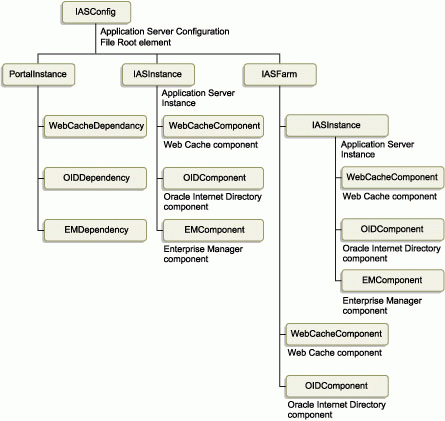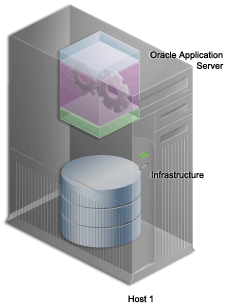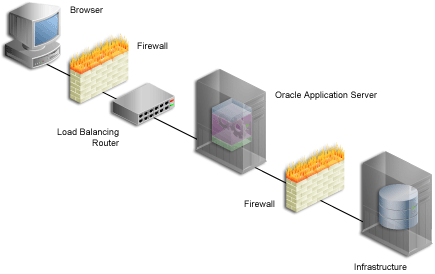10g (9.0.4)
Part Number B10356-01
Home |
Solution Area |
Contents |
Index |
| Oracle® Application Server Portal Configuration Guide 10g (9.0.4) Part Number B10356-01 |
|
OracleAS Portal is dependent on the components: Oracle Application Server Web Cache and Oracle Internet Directory. It is important that you understand these dependencies, as it may be necessary to fine tune or configure these components after Oracle Application Server is installed.
To simplify configuration changes, OracleAS Portal introduces the Portal Dependency Settings File (iasconfig.xml). This file stores configuration data from all the dependent components in a central place and the content of the file is updated when there are configuration changes.
You can use the Portal Dependency Settings file to:
This appendix discusses the Portal Dependency Settings, and the Portal Dependency Settings tool in the following two sections:
The following sections describe the Portal Dependency Settings file in more detail:
The name of the Portal Dependency Settings file is iasconfig.xml, and is located by default in ORACLE_HOME/portal/conf, where ORACLE_HOME is the OracleAS Portal and Oracle Application Server Wireless middle-tier home.
When using any of the tools that access the Portal Dependency Settings file, you can override the default location of the file by setting the environment variable IASCONFIG_LOC to the directory in which your file is stored, for example:
set IASCONFIG_LOC=/usr/local/ias904
If the Portal Dependency Settings file is accessible over a network file system, you can share the file across multiple hosts, avoiding the need to manually replicate it every time the file is modified. If the installation is running on an operating system which supports symbolic links, it is recommended that you use this mechanism to reference a shared file, instead of setting the IASCONFIG_LOC environment variable.
If, however, the Portal Dependency Settings file is not accessible over the network, you must ensure that the file is kept up-to-date with changes to your site topology. The Portal Dependency Settings file is used to configure the Portal Repository with details of OracleAS Web Cache, Oracle Internet Directory and Oracle Enterprise Manager that it is using. It is not required that it is copied into each individual middle-tier in your site, but you must ensure that any changes to the components modeled in the file that affect OracleAS Portal configuration are updated in the file.
To demonstrate how the Portal Dependency Settings file is kept up-to-date, let's use the configuration defined in Section 5.3, "Configuring Multiple Middle-Tiers with a Load Balancing Router".
This file will be located on machine m1.abc.com, typically in ORACLE_HOME/portal/conf of the middle-tier that has just been installed.
This file will be on machine m1.abc.com, typically in ORACLE_HOME/portal/conf of the middle-tier installed in Step 1. You use the ptlconfig tool as shown in Section A.2.1, "Portal Dependency Settings Tool", after you make changes to the file.
Any future changes to the OracleAS Web Cache, Oracle Internet Directory, or Oracle Enterprise Manager settings in iasconfig.xml should be made using the Application Server Control, or by hand on m1.abc.com. You must also use the ptlconfig tool again after you make changes.
|
Note: Changes to OracleAS Portal's OracleAS Web Cache settings can also be made on the Portal Web Cache Settings page, as described in Section 7.2.3, "Portal Web Cache Settings Page". Typically, the hostname and port number, by which OracleAS Portal is addressed, uses the OracleAS Web Cache hostname and port number. This is because, in a simple configuration, browser requests go directly to OracleAS Web Cache. However, in a configuration that has a load balancing router (LBR), or reverse proxy server front-ending OracleAS Web Cache, the hostname and port number defined on this page may need to reflect that of the LBR, or reverse proxy server.
In this configuration, you want OracleAS Web Cache invalidation messages to be sent directly to the OracleAS Web Cache host, as opposed to the LBR, or reverse proxy server. In the scenario where your published hostname is different from the hostname used for OracleAS Web Cache invalidation, you cannot use the Portal Web Cache Settings page in the Oracle Enterprise Manager Application Server Control, or the Portal Dependency Settings file |
The Portal Dependency Settings file is an XML file, that is made up of a number of elements that describe the settings of specific Oracle Application Server components and the dependencies Portal instances have on them. Figure A-1 shows all the elements that can be modeled in the Portal Dependency Settings file. The Portal Dependency Settings file definition is modeled in the schema file iasconfig.xsd, which is located in ORACLE_HOME/portal/conf.

The individual elements are:
The IASFarm element represents a logical farm of Oracle Application Server instances.
| Attribute Name | Type | Description |
|---|---|---|
|
Name |
String |
Unique farm name |
|
Host |
String |
Logical host machine |
The IASInstance element represents a specific Oracle Application Server instance, which usually maps to an Oracle home.
| Attribute Name | Type | Description |
|---|---|---|
|
Name |
String |
Oracle Application Server instance name (for example, |
|
Host |
String |
Host machine |
|
Version |
String |
Version of Oracle Application Server. |
These are the OracleAS Portal instance settings.
These are the OracleAS Web Cache settings.
These are the Oracle Internet Directory settings.
These are the Oracle Enterprise Manager Application Server Control settings.
| Attribute Name | Type | Description |
|---|---|---|
|
ConsoleHTTPPort |
Integer |
Listening port |
|
SSLEnabled |
String |
Flag to indicate whether the listening port is SSL enabled. The value can either be |
This is the OracleAS Portal instance reference to the OracleAS Web Cache it is using.
This is the OracleAS Portal instance reference to the Oracle Internet Directory it is using.
This is the Oracle Enterprise Manager Application Server Control managing this OracleAS Portal instance.
The following XML represents the contents of a sample Portal Dependency Settings file:
<IASConfig XSDVersion="1.0"> <IASInstance Name="iAS-1" Host="abc.company.com" Version="9.0.4"> <WebCacheComponent AdminPort="3001" ListenPort="3002" InvalidationPort="3003" InvalidationUsername="orcladm" InvalidationPassword="orcladm=" SSLEnabled="false"/> </IASInstance> <IASInstance Name="iAS-2" Host="xyz.company.com" Version="9.0.4"> <OIDComponent AdminPassword="orcladm" PortSSLEnabled="false" LDAPPort="3002" AdminDN="cn=orcladmin"/> <EMComponent ConsoleHTTPPort="1814" SSLEnabled="false"/> </IASInstance> <PortalInstance DADLocation="/pls/portal" SchemaUsername="portal" SchemaPassword="welcome1" ConnectString="xyz.company.com:1521:s901dev3"> <WebCacheDependency ContainerType="IASInstance" Name="iAS-1"/> <OIDDependency ContainerType="IASInstance" Name="iAS-2"/> <EMDependency ContainerType="IASInstance" Name="iAS-2"/> </PortalInstance> </IASConfig>
In this example, the OracleAS Portal instance is:
When OracleAS Portal is installed, the OracleAS Portal Configuration Assistant (OPCA) creates appropriate entries in the Portal Dependency Settings file, based on what is installed.
In an Application Server installation, the dependencies of OracleAS Portal on Oracle Application Server Web Cache and Oracle Internet Directory are added to the Portal Dependency Settings file. Existing information is not updated if duplicate entries are encountered during the installation. Instead, a warning is output to the installation log file that the entries already exist.
|
See Also:
Chapter 3, "Installing OracleAS Portal" for more information about the different installation types. |
<IASConfig XSDVersion="1.0"> <IASInstance Name="iAS-1" Host="abc.company.com" Version="9.0.4"> <OIDComponent AdminPassword="orcladm" PortSSLEnabled="false" LDAPPort="3002" AdminDN="cn=orcladmin"/> </IASInstance> <IASInstance Name="iAS-2" Host="abc.company.com" Version="9.0.4"> <WebCacheComponent AdminPort="3001" ListenPort="3002" InvalidationPort="3003" InvalidationUsername="orcadm" InvalidationPassword="orcladm=" SSLEnabled="false"/> </IASInstance> <PortalInstance DADLocation="/pls/portal" SchemaUsername="portal" SchemaPassword="welcome1" ConnectString="xyz.company.com:1521:s901dev3"> <WebCacheDependency ContainerType="IASInstance" Name="iAS-2"/> <OIDDependency ContainerType="IASInstance" Name="iAS-1"/> </PortalInstance> </IASConfig>
This section shows what the Portal Dependency Settings file looks like in the recommended topologies.
The topology for this common configuration is seen in Figure A-2.

This configuration assumes that both the application server and the infrastructure are installed on the same machine, called Host 1.
When you install the Infrastructure on Host 1 in Oracle home OH_2, no changes are made to the Portal Dependency Settings file.
When you install OracleAS Portal and OracleAS Wireless on Host 1 in Oracle home OH_1, referencing the Oracle Internet Directory instance in OH_2, the Portal Dependency Settings file looks like this:
<IASConfig XSDVersion="1.0"> <IASInstance Name="host1.OH_1" Host="host1.us.oracle.com" Version="9.0.4"> <WebCacheComponent AdminPort="3001" ListenPort="7778" InvalidationPort="3003" InvalidationUsername="orcadm" InvalidationPassword="orcladm=" SSLEnabled="false"/> </IASInstance> <IASInstance Name="host1.OH_2" Host="host1.us.oracle.com" Version="9.0.4"> <OIDComponent AdminPassword="orcladm" PortSSLEnabled="false" LDAPPort="3002" AdminDN="cn=orcladmin"/> </IASInstance> <PortalInstance DADLocation="/pls/portal" SchemaUsername="portal" SchemaPassword="welcome1" ConnectString="host1.us.oracle.com:1521:iasdb"> <WebCacheDependency ContainerType="IASInstance" Name="host1.OH_1"/> <OIDDependency ContainerType="IASInstance" Name="host1.OH_2"/> </PortalInstance> </IASConfig>
The topology for this common configuration is seen in Figure A-3.

Text description of the illustration cg_monit_enterprise.gif
This configuration assumes that the application server and the infrastructure are installed on different machines.
When you install the entire infrastructure, no changes are made to the Portal Dependency Settings file.
As shown in Figure A-3, the OracleAS Web Cache cluster front-ending OracleAS Portal is not yet known. When you install the application server (Portal and Wireless installation) on host Host 1 in Oracle home OH_1, referencing the Oracle Internet Directory on host Host 2, the configuration will look like this:
<IASConfig XSDVersion="1.0"> <IASInstance Name="host2.OH_2" Host="host2.us.oracle.com" Version="9.0.4"> <OIDComponent AdminPassword="orcladm" PortSSLEnabled="false" LDAPPort="3002" AdminDN="cn=orcladmin"/> </IASInstance> <IASInstance Name="host1.OH_1" Host="host3.us.oracle.com" Version="9.0.4"> <WebCacheComponent AdminPort="3001" ListenPort="7778" InvalidationPort="3003" InvalidationUsername="orcladm" InvalidationPassword="orcladm=" SSLEnabled="false"/> </IASInstance> <PortalInstance DADLocation="/pls/portal" SchemaUsername="portal" SchemaPassword="welcome1" ConnectString="host1.us.oracle.com:1521:iasdb"> <WebCacheDependency ContainerType="IASInstance" Name="host1.OH_1"/> <OIDDependency ContainerType="IASInstance" Name="host2.OH_2"/> </PortalInstance> </IASConfig>
If you want the application server on Host 1 to be front-ended by OracleAS Web Cache (item 5 in the image), you need to manually edit the Portal Dependency Settings file. First, remove the existing OracleAS Web Cache entry and then create an OracleAS Web Cache entry that belongs to a farm. The modified Portal Dependency Settings file will now look like this:
<IASConfig xmlns="http://www.oracle.com/iAS/iASConfigFile" XSDVersion="1.0"> <IASInstance Name="host2.OH_2" Host="host2.us.oracle.com" Version="9.0.4"> <OIDComponent AdminPassword="orcladm" PortSSLEnabled="false" LDAPPPort="3002" AdminDN="cn=orcladmin"/> </IASInstance> <IASFarm name="Farm_1" host="frontend.us.oracle.com"> <WebCacheComponent AdminPort="3001" ListenPort="7778" InvalidationPort="3003" InvalidationUsername="orcladm" InvalidationPassword="orcladm=" SSLEnabled="false"/> </IASFarm> <PortalInstance DADLocation="/pls/portal" SchemaUsername="portal" SchemaPassword="welcome1" ConnectString="host1.us.oracle.com:1521:iasdb"> <WebCacheDependency ContainerType="IASFarm" Name="Farm_1"/> <OIDDependency ContainerType="IASInstance" Name="host2.OH_2"/> </PortalInstance> </IASConfig>
The OracleAS Portal instance now references the virtual OracleAS Web Cache front-ending it.
Finally, you must run ptlconfig to change the settings stored in the OracleAS Metadata Repository:
ptlconfig -encrypt ptlconfig -all
The following sections describe the available configuration tools, and the state of the portal dependency settings file in various topologies, in more detail:
To update the OracleAS Metadata Repository with configuration settings in iasconfig.xml, you must use the script ptlconfig. This script can:
The configuration script file is named ptlconfig (on UNIX) and ptlconfig.bat (on Windows). It is located in ORACLE_HOME/portal/conf, where ORACLE_HOME is the OracleAS Portal and OracleAS Wireless middle-tier home.
You can use this script as follows:
ptlconfig (-all | -dad <dad>) [-wc] [-oid] [-site] [-em] | -encrypt
When you run this script, the log file ptlconfig.log is created in the directory ORACLE_HOME/portal/logs, which records operations performed on the OracleAS Metadata Repository.
Oracle Enterprise Manager Application Server Control also enables you to configure how an OracleAS Portal instance integrates with its dependent components. When you use Application Server Control to configure Portal Web Cache settings, the log file ptlemcfg.log is created in the directory ORACLE_HOME/portal/logs. This log file contains information about the operations performed on the OracleAS Metadata Repository. See Chapter 7, "Monitoring and Administering OracleAS Portal" for more information.
|
|
 Copyright © 2002, 2003 Oracle Corporation. All Rights Reserved. |
|